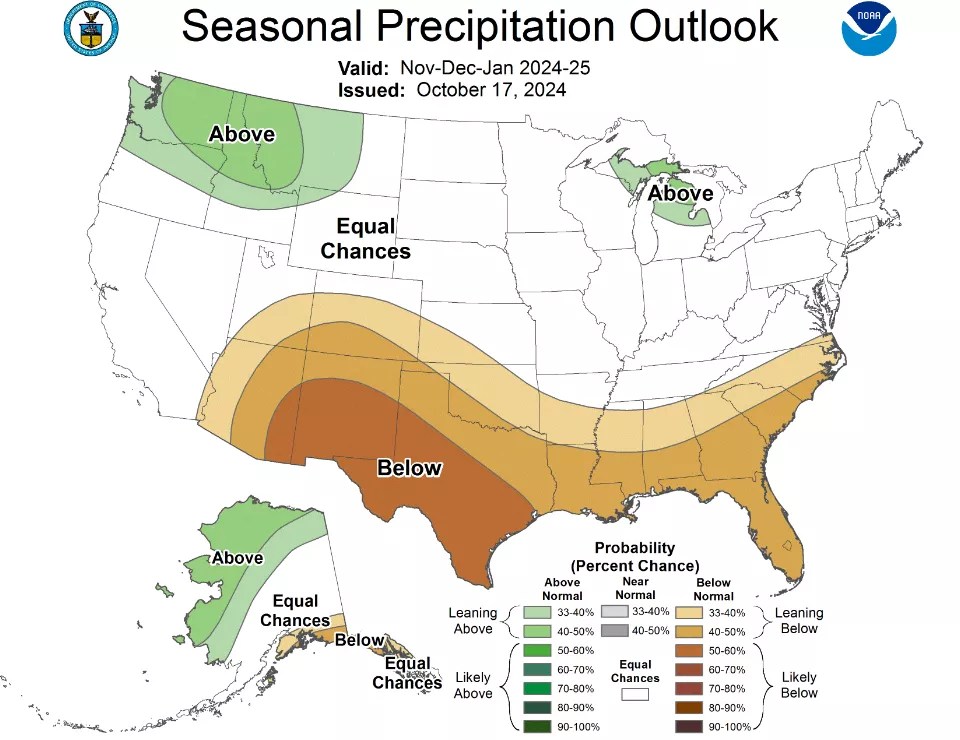
Photo by Dan Cederholm / Flickr

Audio By Carbonatix
Winter’s not far around the corner, so we can all start looking forward to digging our puffy coats and Uggs out of the back of the closet and watching the iguanas fall out of the trees, right?
Not so fast. According to the latest forecast from the National Weather Service’s Climate Prediction Center, Miami is in for a weather shift this winter, but not necessarily a chilly one, thanks to the return of La Niña.
“La Niña is favored to emerge in September-November (60 percent chance) and is expected to persist through January-March 2025,” the report states. And as of mid-October, the long-range forecast for November through January anticipates a good chance for warmer and drier conditions in South Florida.

As of mid-October, the long-range forecast leans toward higher precipitation during the winter months of 2024-25.
We’re thankful for you. Are you thankful for us?
We feel thankful for our staff and for the privilege of fulfilling our mission to be an unparalleled source of information and insight in Miami. We’re aiming to raise $30,000 by December 31, so we can continue covering what matters most to this community.
Help us continue giving back to Miami.
“The three-month outlooks show decent odds of it being warmer and drier than average here,” says meteorologist Brian McNoldy, a senior research associate at the University of Miami.
La Niña, the flip side of El Niño, occurs when cooler-than-average sea surface temperatures take over the central and eastern Pacific Ocean. This has ripple effects on weather patterns around the globe, including in Miami. Historically, La Nina tends to pull moisture away from the region, leading to less rainfall and higher temperatures, especially in winter.

As of mid-October, the long-range forecast leans toward lower precipitation during the (typically dry) winter months of 2024-25.
So, What Does This Mean for Miami?
For Miami, this likely means a warm, dry winter. The Climate Prediction Center notes that while this La Niña event is expected to be weak and short-lived, it still stands to bring some of the typical impacts we’ve seen in the past. The report describes a “weak and short duration La Niña” but acknowledges that “predictable signals could still influence the forecast guidance.” Translation: Even a mild La Niña can still affect our weather patterns.
On the cautionary side, hurricane season technically ends November 30, but La Niña might drag out tropical storm activity a bit longer. The forecast highlights that “low-level wind anomalies were easterly over the east-central equatorial Pacific,” which aligns with conditions that tend to extend hurricane season. While Miami’s odds of dealing with more storms are lower as the season winds down, it’s not impossible.
How Long Will La Niña Stick Around?
The forecast gives this edition of La Niña a short run, with experts predicting it will stick around until at least March 2025. Again, though this emergent La Niña isn’t expected to be a significant one. The Climate Prediction Center team “still favors a weak event but has lowered the chances of La Niña.”
So we’re likely to feel some of the usual effects – i.e., drier days and milder temps – but nothing too wildly extreme.
This winter might mean more beach days for South Floridians. But a dry winter could spell trouble for water resources and agriculture, so it’s worth keeping an eye on how conditions develop as we head into the end of the year.